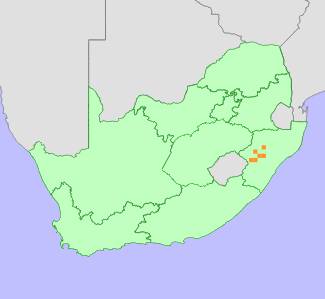|
Scientific Name | Orbea woodii (N.E.Br.) L.C.Leach |
Higher Classification | Dicotyledons |
Family | APOCYNACEAE |
Synonyms | Orbea woodii (N.E.Br.) L.C.Leach var. westii R.A.Dyer, Stapelia woodii N.E.Br., Stapelia woodii N.E.Br. var. westii R.A.Dyer |
National Status |
Status and Criteria | Vulnerable B1ab(iii,iv,v)+2ab(iii,iv,v) |
Assessment Date | 2023/11/23 |
Assessor(s) | N.N. Mhlongo, J.E. Victor, D. Styles & C.R. Scott-Shaw |
Justification | This species has a limited distribution range and has an extent of occurrence (EOO) of 3942 km ², and an area of occupancy (AOO) of 36 km². It is known from between five and ten locations and the population is declining due to illegal collection to supply the local traditional medicine trade and possibly the succulent trade. Suitable habitat within the species' range has also been transformed by agriculture and infrastructure developments. It therefore qualifies as Vulnerable under criterion B. |
Distribution |
Endemism | South African endemic |
Provincial distribution | KwaZulu-Natal |
Range | This species is endemic to KwaZulu-Natal, where it occurs along the Tugela River Valley. |
Habitat and Ecology |
Major system | Terrestrial |
Major habitats | Thukela Thornveld, Thukela Valley Bushveld, KwaZulu-Natal Highland Thornveld |
Description | Plants occur in valley thicket and savanna, open and closed dry woodland, on gently sloping areas of shale with dolerite rocks, between stones and small tufts of grass in open places, 800-1200 m. |
Threats |
| This species is exploited for medicinal use, and plants in this genus hold horticultural value, making them highly sought after by succulent collectors globally. At least 75% of this species' habitat has been irreversibly transformed (calculated using GIS). Large parts of KwaZulu-Natal, including the range of this species, have undergone transformation due to agriculture, timber plantations, and infrastructure developments (Jewitt et al., 2015). |
Population |
No quantitative population data are available for this species. Field surveys are required.
|
Population trend | Decreasing |
Assessment History |
Taxon assessed |
Status and Criteria |
Citation/Red List version | | Orbea woodii (N.E.Br.) L.C.Leach | VU B1ab(v) | Raimondo et al. (2009) | | Orbea woodii (N.E.Br.) L.C.Leach | VU B1B2abcde | Scott-Shaw (1999) | | Orbea woodii (N.E.Br.) L.C.Leach | Rare | Hilton-Taylor (1996) | | Orbea woodii (N.E.Br.) L.C.Leach | Uncertain | Hall et al. (1980) | |
Bibliography |
Bruyns, P.V. 2002. Monograph of Orbea and Ballyanthus (Apocynaceae-Asclepiadoideae-Ceropegieae). Systematic Botany Monographs 63:1-196.
Bruyns, P.V. 2005. Stapeliads of southern Africa and Madagascar. (Vol. 1, pp. 1-330). Umdaus Press, Pretoria.
Hall, A.V., De Winter, M., De Winter, B. and Van Oosterhout, S.A.M. 1980. Threatened plants of southern Africa. South African National Scienctific Programmes Report 45. CSIR, Pretoria.
Hilton-Taylor, C. 1996. Red data list of southern African plants. Strelitzia 4. South African National Botanical Institute, Pretoria.
Raimondo, D., von Staden, L., Foden, W., Victor, J.E., Helme, N.A., Turner, R.C., Kamundi, D.A. and Manyama, P.A. 2009. Red List of South African Plants. Strelitzia 25. South African National Biodiversity Institute, Pretoria.
Scott-Shaw, C.R. 1999. Rare and threatened plants of KwaZulu-Natal and neighbouring regions. KwaZulu-Natal Nature Conservation Service, Pietermaritzburg.
Todd, S. 2012. Environmental Impact Assessment for the establishment of the Wolseley wind farm, Western Cape province. Fauna & Flora Specialist Study. Sagit Energy Ventures.
|
Citation |
| Mhlongo, N.N., Victor, J.E., Styles, D. & Scott-Shaw, C.R. 2023. Orbea woodii (N.E.Br.) L.C.Leach. National Assessment: Red List of South African Plants version 2024.1. Accessed on 2025/11/26 |
 Comment on this assessment
Comment on this assessment


